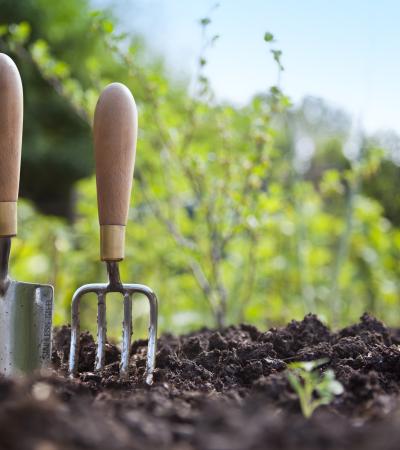As part of a weeklong series of programs to celebrate National Library Week, The Bunn Library hosted a DIY Terrarium Workshop during lunch for faculty, staff and students. Participants created small succulent gardens to decorate their desks, workspaces or dorm rooms, and relished in the opportunity to take a break from the stresses of the day to dig around in the dirt and create something.
Advanced Planning
Goals and Intended Outcomes
We decided to hold this workshop during National Library Week as part of a series of programs to celebrate the diverse role of the library. Initially, the event was geared more toward staff and faculty as a lunchtime workshop, but we decided to open up the program to students to increase participation. We offered the class for 25 people with registration required in advance.
I chose DIY terrariums as a project because I wanted to do something that was more hands-on, yet wasn’t a craft that required advanced skill or previous training in order to be successful. I liked that this idea also capitalized on the maker movement and STEM-focused programs in libraries, yet did not target technology. I would like to offer more maker-driven programming at the library, and this workshop was my first attempt to gauge the level of interest on campus.
Planning
I started planning the workshop three weeks prior by doing some research on the steps and supplies needed to construct a simple terrarium. Most of the planting supplies (such as rocks, soil and moss) I could easily obtain at a local hardware store, such as Home Depot. After researching container options, I chose to purchase quart-sized Mason jars with wide lids because they were the cheapest in bulk and had a larger opening for easier planting. After I finished buying supplies, I created an infographic handout with information about the plants, steps to complete the terrarium, and care instructions. (View this handout under Attachments at right.)
Challenges
The challenge of this workshop was to buy enough supplies for a larger group while keeping a reasonable budget. Depending on the type of plants and containers that you choose — and if you are trying to accomplish this program on a relatively small budget — this is could be a significant obstacle due to expense. This first became evident to me when I was looking into purchasing plants; I decided to use succulents because they are beautiful as well as hardy (ideally harder to kill for people with little gardening experience), but I did not realize that buying enough plants for 25 people could be costly. After doing some research I found that the cheapest option was to order plants online in bulk, and even then the succulents comprised a majority of my budget. I ordered 84 small succulent plugs (baby plants) from Mountain Crest Gardens , which allowed each participant to have at least two in their terrarium.
Marketing
We rolled the marketing for this program into our marketing for National Library Week, with emails to the school community, advertising on the library website, and printed fliers posted in the building. I used Canva to create the publicity materials. (View these materials under Attachments at right.) This program had very little marketing, yet was a very successful part of National Library Week, and even one of our most buzzed-about programs on campus this year.
I had initially limited registration to 25 people, but fortunately bought a few more supplies that I thought I would need because I had over 30 people attend the workshop. The most successful part of this program, in my opinion, was the diversity of the participants from all over campus, with students, faculty and staff all in attendance.
Budgeting
This project has a tendency to get expensive, so I would suggest having a firm limit on the number of participants; supplies that may not seem expensive on a small scale suddenly become exorbitant when buying for 25 or more people. I would also recommend determining what you already have on hand that could supplement buying materials, or ask patrons to provide some of their own supplies (such as a container) to cut costs. Our workshop averaged $6 to $7 per person and included all of the following supplies to build a complete terrarium:
- small rocks or stones for the base of the container and for decoration
- Spanish moss to layer over the stones and to help with drainage
- sand, which adds more color to the terrarium and helps with drainage; it also looks nice at the top of the terrarium as decoration
- potting soil made especially for cactus plants
- plants, such as succulents; it is important to note that succulents should only be housed in open air terrariums (without a lid) because they do better in a drier climate with less moisture and humidity
- additional (optional) decorations such as stones, glass beads, peat moss or miniature figures
Day-of-event Activity
I covered the tables in our largest meeting room with vinyl tablecloths, which made for easier clean-up after the program; all I had to do was roll up the cloths with the dirt and sand and throw them into the trash. The tables were set up with all the necessary supplies, including an empty glass jar and set of instructions at every chair.
The program was advertised to take place during lunch (around 12 to 1:30 p.m.), yet I had to take into account that different groups of people (faculty, staff and students) had slightly different schedules. To accommodate this, I allowed participants to get started as they arrived without waiting for the entire group, and I answered questions or replenished materials as needed.
I had two other librarians assist with set-up and clean-up, but only one person was really needed to facilitate the project, so I was the only staff member in the room the entire time.
Program Execution
Once participants started to arrive the program was very easy to facilitate. I instructed each person to take an open seat and then let them get to work as they saw fit, checking in on each table to see if they needed anything.
I received very positive feedback from those who attended the workshop, with comments on how relaxing it was to be able to dig into soil and create something during a stressful day.
Advice
If you are planning to run a program like this in the future, my strong advice would be to start planning earlier so that you are not forced to make potentially more expensive choices at the last minute. Research what type of terrarium you would like to make (either open or closed), and price out supplies well in advance to cut money spent in shipping, if necessary, and to limit your stress.
If you have flexibility in your budget, buy more supplies than you think you may need and keep the receipts so you can return the unused merchandise. I was glad to have the additional materials and ended up dipping into my extra stock to accommodate participant needs.


